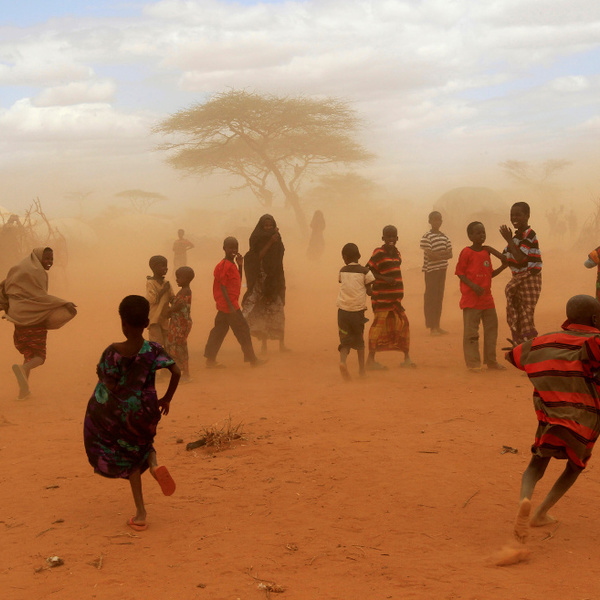Sending Dadaab’s refugees back to Somalia will become the next health emergency.
COMMENT
Sitting in a shelter made of branches and torn fabric, Amina cradles a small boy on her lap. The child is listless and shockingly thin. He is severely malnourished and needs to get to hospital fast.
This was one of many stories five years ago, during the height of a malnutrition emergency in Somalia, causing thousands to cross the border to Kenya. Amina and her five children had just arrived in Kenya’s Dadaab refugee camp, after walking from the Somali border, 70km away across the baking red desert.
They had been driven from their village by a long and vicious war and a terrible two-year drought. Thousands of other Somalis were arriving at Dadaab each month, weak from the long walk and having had too little to eat. Doctors Without Borders (MSF) data show that one in five of the newly-arrived children was severely malnourished, and at MSF’s hospital in the camp, staff were rushing to put up tents to make more space for the sick and the dying.
That emergency was in 2011. The MSF hospital staff have since dismantled the extra tents and the health situation in Dagahaley camp has somewhat stabilised. But in such a precarious environment, things could change at any time. In a vast camp like Dadaab — which houses about 350 000 refugees, and where people live on top of each other, with poor sanitation and limited food rations — infectious diseases can spread like wildfire.
Last year saw a major outbreak of cholera in the camp, and there are regular cases of measles, mainly among new arrivals from Somalia. MSF’s hospital sees a constant stream of people with diarrhoeal diseases, skin diseases, respiratory tract infections and malnutrition.
Mental health conditions among the population are common. At the same time, chronic diseases, including diabetes, hypertension and end-stage cancers, are also on the rise. MSF’s team is always on its toes, wondering where the next health crisis will come from.

Closure of Dadaab camp
And now the next potential crisis has appeared, this time from an unexpected direction. The Kenyan government announced in May that it will close Dadaab and send all its residents back to Somalia — the very place they are seeking refuge from. No one would say that life in Dadaab refugee camp is good for your health.
Denied the right to work or to travel, with no opportunity to become integrated into Kenyan society and with little hope of being resettled abroad, depression and other mental health disorders are common among the refugees; around two percent of the population in Dagahaley camp are on psychiatric medication, according to MSF data.
In addition to the other myriad health risks of the camp, patients in need of advanced healthcare face difficulties getting referrals to specialist hospitals elsewhere. But the health consequences of being forcibly returned to Somalia will be a great deal worse.
Facts about the health situation in much of Somalia are sketchy — because of the insecurity, few journalists or aid workers venture there. But we do know that, in large parts of the country, even basic healthcare services are scarce or nonexistent. In Dadaab, MSF often finds that children arriving from Somalia have never been vaccinated against common childhood diseases — another telling indication of the health landscape there.
Few families have so far taken the decision to return to Somalia despite an agreement signed in 2013 between the governments of Kenya and Somalia and the United Nations High Commissioner of Refugees. This recent announcement by the Kenyan government strips refugees of any choice. If the return of the refugees is not done voluntarily, it is likely to have major consequences for their health, escalating their vulnerability to malnutrition, weakening their immune systems and making them vulnerable to infectious diseases.
People with incommunicable diseases will also be at increased risk, as symptoms do not usually become severe until an advanced stage of the disease, lessening their impetus, in a difficult situation, to seek healthcare until it is too late.
Patients with chronic diseases and who are already on medication need continuity of care to safeguard their health — whether they are diabetics who need insulin, or people with hypertension who need ongoing treatment. With diseases such as tuberculosis, interrupted treatment brings with it the risk of drug-resistance developing, and if a patient with psychosis is forced to come off their medication, their cognitive function and behaviour development goes into reverse.
If the Kenyan government goes ahead with the threatened closure of Dadaab, I dread the thought of what will happen to MSF’s patients and the most vulnerable refugees. Sending the camp’s residents back to Somalia without due care is likely to become the next health emergency.
Melat Haille is the medical co-ordinator for Médecins Sans Frontières.
Melat Haille is the medical co-ordinator for Médecins Sans Frontières.
